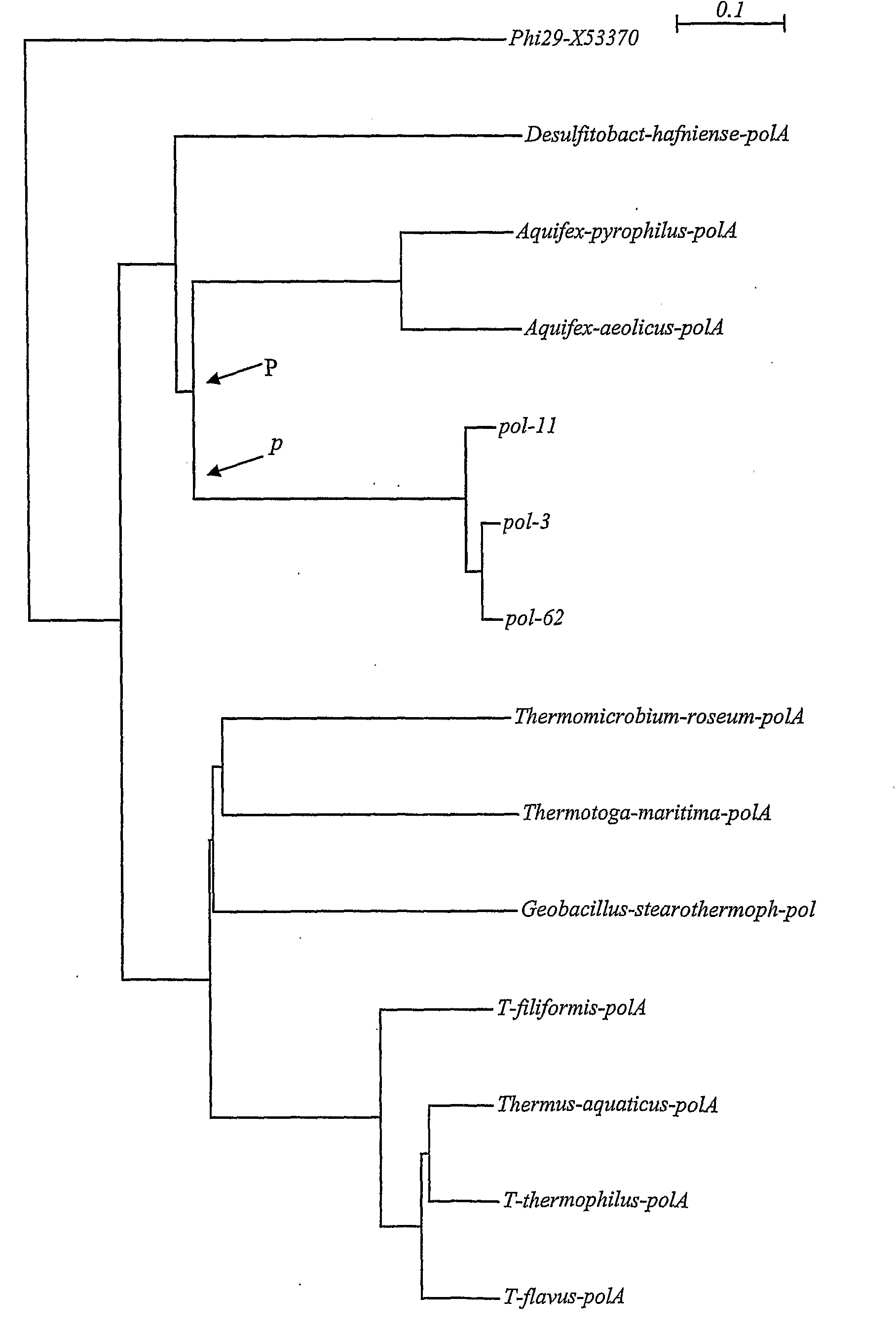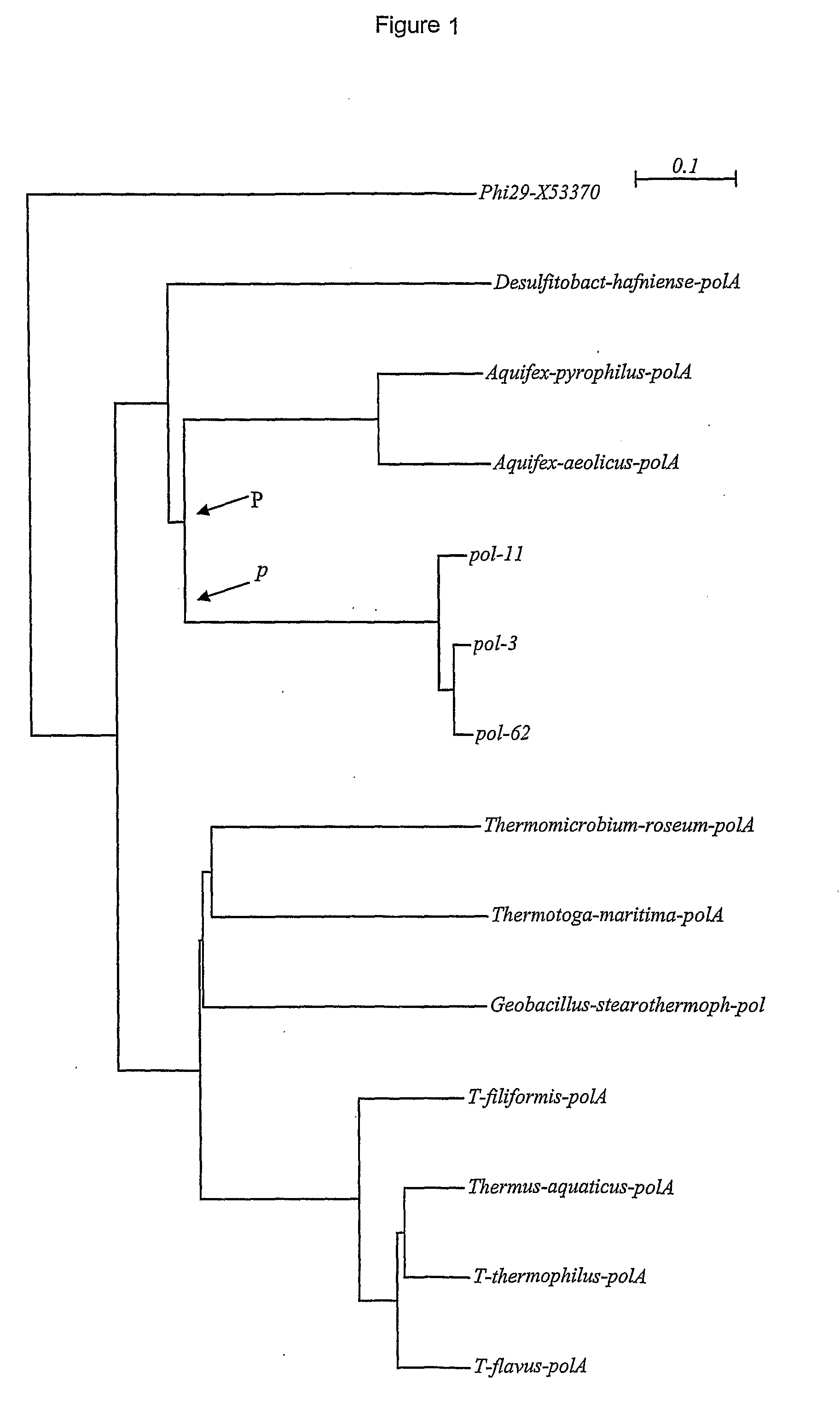Dna Polymerases Having Strand Displacement Activity
a strand displacement activity and polymerase technology, applied in the field of dna polymerases having strand displacement activity, can solve the problems of limited amount of available dna, such as clinical samples, and the apparent inefficiency of phi29 dna polymerase, and achieve the effect of rapid and efficient strand displacement amplification reactions
- Summary
- Abstract
- Description
- Claims
- Application Information
AI Technical Summary
Benefits of technology
Problems solved by technology
Method used
Image
Examples
example 1
Bacterial Strains and DNA Isolation
[0172]In this work a number of strains of Thermus and Meiothermus were used. The strains were from the collection of Prokaria ltd. and represented all described Thermus species as well as few Meiothermus spp. The strains were all isolated from various geothermal fields in Iceland except for some of the reference strains. The selection of strains was based on the genetic relationship of 101 Icelandic Thermus strains based on a MEE analysis of 10 enzyme loci reported by Skirnisdottir et al. 2001 (Skirnisdottir, 2001) as well as on the DNA polymerase activity screening of thermophilic DNA polymerases from Icelandic Thermus strains reported by Hjorleifsdottir et al. 1997 (Hjorleifsdottir et al., 1997). Type strains of the following Thermus species were used as reference in the study: Thermus aquaticus strain YT-1 (DSM 625; type strain), Thermus brockianus strain YS38 (NCIMB 12676; type strain), Thermus filiformis strain Wal33 A.1 (DSM 4687, type strain...
example 2
Amplification of Gene Fragments and Construction of Gene Libraries
[0174]DNA polymerases of family A (Braithwaite and Ito, 1993) have shown to contain 3 conserved sites in the active site of the polymerase domain of the gene (Joyce and Steitz, 1994). The conserved motifs in the active site were used to design degenerate CODEHOP primers (Rose et al., 1998) flanking the region between motifs A and C. The primers used gave approximately 600 base long sequences: A-forw. 5′-GCCGCCGACTACTCCcarathgarht-3′ and C-rev. 5′-cangtrctrctCTACCACAAGCTCCCG-3′. DyNAzyme™ DNA polymerase (Finnzymes) was used as described by the manufacturer. The PCR reaction was done as follows: 94° C. for 5 min, before 30 circles of 94° C. for 50 s, 50° C. for 1 min, 72° C. for 1.5 min and at the end of the program an elongation step at 72° C. for 7 min. In cases when 600 base long PCR products were not retrieved, the annealing temperatures were varied by using a gradient from 40° C. up to 60° C. PCR products were sepa...
example 3
Diversity Analysis of the DNA Polymerase Gene Fragments
[0175]Partial sequencing of the DNA polymerase gene was carried out on 2-8 clones and nucleotide sequences from each strain grouped by using 98% cutoff value in the Sequencer 3.1 software. The consensus sequence of each group was BLAST searched on amino acid level against NCBI Protein Database and closest sequences identified found and collected. The amino acid sequences were then aligned by ClustalX and phylogenetic tree created by using the Neighbor Joining Method. DNA polymerase sequences from representative strains were used for the creation of the polymerase tree. The GeneBank accession numbers of the polymerase sequences used had the following accession numbers Thermus aquaticus AAA27507, Thermus thermophilus P52028, Thermus flavus P30313, Thermus filiformis AAC46079, Aquifex aeoliticus NP214348.
[0176]Some strains revealed a novel type of DNA polymerase, which did not show close relation to Taq DNA polymerase I. Some of th...
PUM
| Property | Measurement | Unit |
|---|---|---|
| molecular weight | aaaaa | aaaaa |
| molecular weight | aaaaa | aaaaa |
| molecular weight | aaaaa | aaaaa |
Abstract
Description
Claims
Application Information
 Login to View More
Login to View More - R&D
- Intellectual Property
- Life Sciences
- Materials
- Tech Scout
- Unparalleled Data Quality
- Higher Quality Content
- 60% Fewer Hallucinations
Browse by: Latest US Patents, China's latest patents, Technical Efficacy Thesaurus, Application Domain, Technology Topic, Popular Technical Reports.
© 2025 PatSnap. All rights reserved.Legal|Privacy policy|Modern Slavery Act Transparency Statement|Sitemap|About US| Contact US: help@patsnap.com



